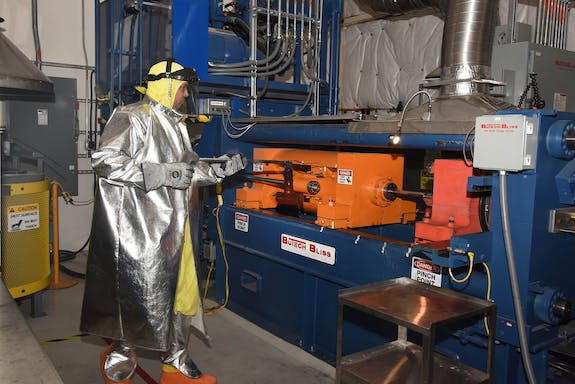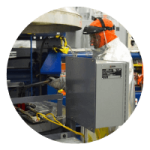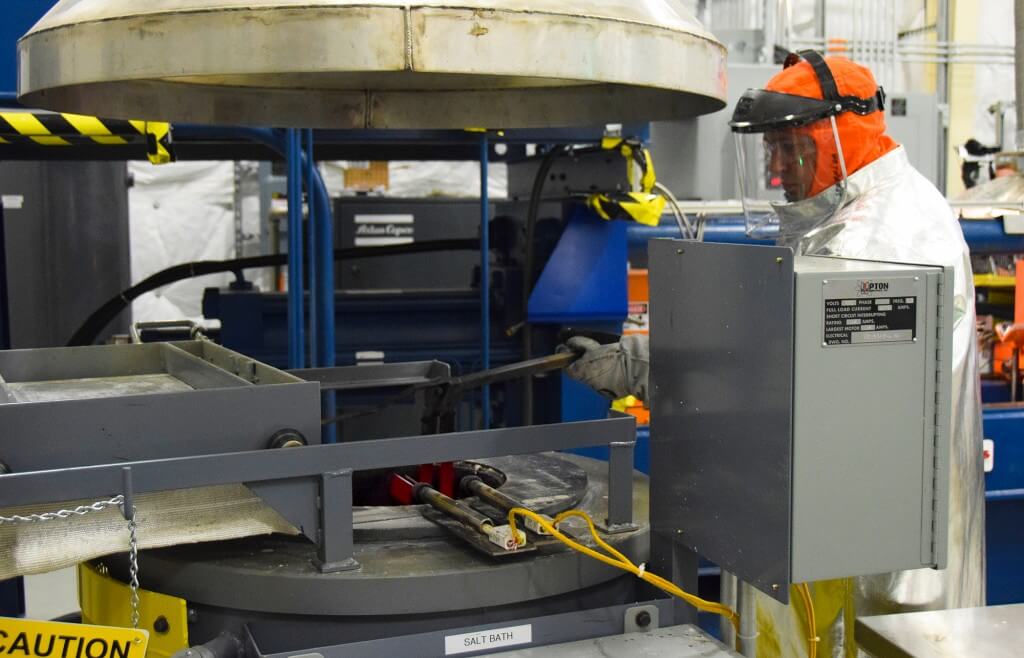The fuel for TerraPower’s new nuclear energy concept is ready to go inside a reactor.
It’s not going into the company’s advanced Traveling Wave Reactor, but instead to an experimental test bed at Idaho National Laboratory that will reveal key details about the new extruded metallic fuel to aid the licensing process.
The fuel pins were fabricated at INL’s Materials and Fuels Complex (MFC). As part of the LDC-1A Fuel Irradiation Test which started in July, INL’s Advanced Test Reactor began bombarding the fuel pins with neutrons for 300 days. The test will reveal how the new fuel stacks up to proven fuels.

Employees from INL and TerraPower have worked together since 2013 on designing and fabricating an acceptable extruded U10Zr (uranium/zirconium alloy) nuclear test fuel at MFC’s Experimental Fuels Facility (EFF). The group settled on extrusion, a process proven in the 1960s but hasn’t been used to fabricate fuel for a modern fast reactor like the TWR.
The testing stage at ATR marks an important milestone for INL and its corporate partner, providing valuable data on how the new fuel compares to its predecessors.
“The test was designed to provide a direct comparison between the performance of historic injection cast fuel and extruded fuel,” TerraPower’s Brian Morris said. “This comparison is crucial to the licensing effort associated with extruded fuel to demonstrate that the historic injection cast fuel performance database is applicable to extruded fuel.”
Over the past five years, staff from INL and TerraPower worked together outfitting EFF before performing a series of complex tests using various alloys that enabled the team to achieve its technical objectives. The INL/TerraPower team performed more than 100 test extrusions, learning about the process itself as well as extrusion dies, tooling material, lubricants, post-extrusion heat treatment and a new irradiation test capsule design.
The ATR testing will help show if the extrusion process can create fuel slugs that perform the same or even better than those previously made from casting methods – like the fuel used in Experimental Breeder Reactor-II.

Instead of injecting melted fuel material into a mold, as was done for EBR-II fuel, these new slugs were made by heating a cylindrical billet of depleted uranium alloy up to 800 degrees Celsius and forcing it through a shaped die to make a long, cylindrical piece of usable material. Simulated fuel slugs are then cut to length, heat treated and inspected. The process produces a thinner, longer form suitable for use as fuel pins (fuel slugs become fuel pins when sealed in stainless steel cladding) for continued experiments and testing. Extruded pins are also cheaper and more efficient to produce, but there are hurdles.
According to INL project technical lead Douglas Porter, the slugs emerge from extrusion with a “pronounced crystal texture, which could influence the fuel performance.” Porter said the slugs are heat-treated to remove the texture.
To see how the extruded fuel compares to casted fuel, the new slugs will be tested alongside an EBR-II legacy fuel type. There’s plenty of history on how the EBR-II fuel type responds to irradiation, and this will help show if the extruded fuel form performs the same or better than the EBR-II fuel. By examining test pins from the experiment, researchers will be able to gather similar information on the new fuel to make that comparison.
Following irradiation the simulated fuel pins will be transferred to MFC facilities to undergo post-irradiation examination (PIE). What is learned there will help determine the fuel’s next step.
“Data on the physical and chemical condition of the fuel rodlets will be used to assess if extruded fuel behaves the same as injection cast fuel, and potentially refine fuel performance models, if needed,” Morris said.
Collaborations like the one between INL and TerraPower are designed to create a faster path for advancing commercial-scale fabrication methods, to qualify and implement an industry partner’s innovative fuel design, and to build a one-stop shop to design, manufacture and test the new fuel in an operating reactor. The collaboration highlights INL’s unique abilities.
“From the feedstock to PIE, we have it all,” said Greg Core, INL’s project manager for the LDC-1A test. “INL is the place to do this.”
 Learn more about INL’s work with TerraPower:
Learn more about INL’s work with TerraPower:
Advanced nuclear reactors will use new types of fuel. To ensure such systems are safe, experimental fuel samples must be fabricated and tested in safe research environments such as those at Idaho National Laboratory.
 Learn more about INL’s nuclear energy R&D facilities:
Learn more about INL’s nuclear energy R&D facilities:
The Advanced Test Reactor (ATR) is the world’s premier nuclear test reactor, and it provides unmatched, national priority nuclear fuel and materials testing capabilities for military, federal, university, and industry partners and customers.





